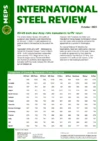Global crude steel production fails to recover in June
Figures from worldsteel show that global crude steel output came to 158.1 million tonnes in June – down 5.9% compared with the same month in 2021. Total outturn for the first half of the year is 949.4 million tonnes.
The restrictions associated with tackling Covid-19 severely affected the Chinese economy in the first half of 2022. Steelmaking in that period declined by 6.5%, year-on-year, to 526.9 million tonnes. Production has begun to recover somewhat as these restrictions have eased. In June, Chinese output totalled 90.7 million tonnes, only 3.3% lower than in the previous year.
East Asia
Production in Japan was down by 8.1%, in June, to 7.4 million tonnes. Japan’s Ministry of Economy, Trade and Industry expects this negative trend to be abated somewhat in the third quarter. However, its forecast for the period still suggests that production will decline by 2.4%, year-on-year, to 23.5 million tonnes.
South Korean steelmakers are similarly affected. Output there fell 6.0%, year-on-year, in June, to 5.6 million tonnes.
India
India is the only one of the top ten steel producing nations to experience growth. Mills in the country boosted their June output to 10.0 million tonnes – an increase of 6.3% compared with the same month in 2021. This takes the half-year total to 63.2 million tonnes.
Figures supplied by the Indian Ministry of Steel show that domestic demand for finished steel products rose by 11% in June. This has helped to moderate the reduction in exports of finished steel. Volumes have been falling since March, even prior to the introduction of the 15% export tax, in May.
Russia & Other Europe
Worldsteel estimates that Russia produced 5.0 million tonnes of crude steel, in June. This is a reduction of over 20%, year-on-year. Recent announcements from several Russian steel companies, such as Severstal and NLMK, support this assessment.
Sanctions and a ban on Russian material entering the EU have severely affected demand from what was until very recently its primary export market. Russian steelmakers have responded by reorienting exports towards Asia. This heavily discounted steel has caused prices for locally produced material to weaken, in those countries.
The rest of the Eurasian region is affected similarly. In June, the combined output of Russia, Ukraine and the other CIS nations declined by more than one third, compared with last year.
Production in Turkey has also suffered. Its June output of 2.9 million tonnes is 13.1% down, year-on-year.
European Union
Local demand has been hampered by the recent high steel prices in Europe, caused by the conflict in Ukraine, and the subsequent panic buying that occurred earlier in the year. Overstocked buyers have consequently been unwilling to pay the prices quoted by mills. The response by many EU steelmakers was to reduce output. Overall, crude steel melting in the region, last month, was more than 12% lower than in June 2021.
Many mills have also announced extensions to the usual holiday shutdown period. Therefore, MEPS expects supply to remain limited throughout the summer, with trading volumes only predicted to recover in September.
Due to its proximity to the conflict, both geographically and politically, German industrial production and economic sentiment are particularly subdued. Domestic mills cut output to 3.2 million tonnes of crude steel, in June – down 7%, year-on-year.
Figures from national steel association, WV Stahl, suggest that EAF-based steelmakers were particularly affected by the downturn. Their monthly output was nearly 9% lower than in 2021. High electricity prices and the comparative ease with which electric arc furnaces can respond to fluctuations in demand made this a likely outcome.
Italian crude steelmaking fell by 14.2%, year-on-year, to 1.8 million tonnes, in June, as mills severely restricted their production to address the issues of overcapacity and falling demand.
Americas
In North America, output remained comparatively stable, in June, declining by 2.4%, year-on-year, to 9.6 million tonnes. During this time, imports of finished steel products into the United States rose to approximately 2.5 million tonnes. The largest suppliers were Canada, Mexico, and South Korea.
The Brazilian Steel Institute confirmed that crude steel production was 2.9 million tonnes, in June – down 5.4% compared with the same month in 2021. Domestic demand fell by 14.4%, to 1.8 million tonnes. However, this was offset by a rise in exports, particularly of high-value steel products. This has led the country’s earnings from foreign sales to increase by nearly 50%, year-on-year.
Meanwhile, production rose to 0.5 million tonnes in Argentina, in June – its highest output since July 2017.

Source:
International Steel Review
The MEPS International Steel Review is an essential monthly publication, offering professional analysis and insight into carbon steel prices around the world.
Go to productRequest a free publication





